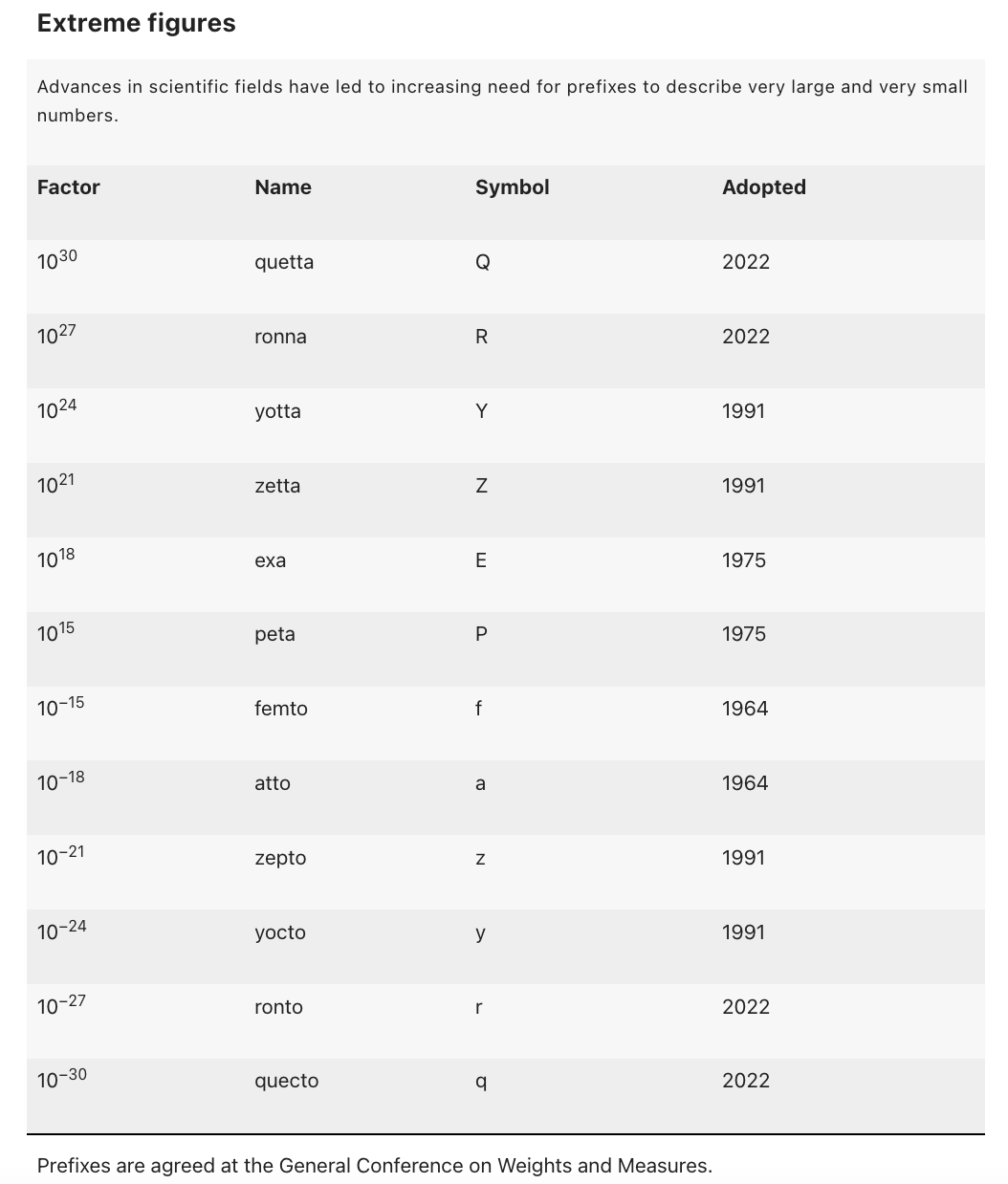By the 2030s, the world will generate around a yottabyte of data per year—that’s 1024 bytes, or the amount that would fit on DVDs stacked all the way to Mars. Now, the booming growth of the data sphere has prompted the governors of the metric system to agree on new prefixes beyond that magnitude, to describe the outrageously big and small.
Representatives from governments worldwide, meeting at the General Conference on Weights and Measures (CGPM) outside Paris on 18 November, voted to introduce four new prefixes to the International System of Units (SI) with immediate effect. The prefixes ronna and quetta represent 1027 and 1030, and ronto and quecto signify 10−27 and 10−30. Earth weighs around one ronnagram, and an electron’s mass is about one quectogram.
This is the first update to the prefix system since 1991, when the organization added zetta (1021), zepto (10−21), yotta (1024) and yocto (10−24). In that case, metrologists were adapting to fit the needs of chemists, who wanted a way to express SI units on the scale of Avogadro’s number—the 6 × 1023 units in a mole, a measure of the quantity of substances. The more familiar prefixes peta and exa were added in 1975 (see ‘Extreme figures’).

Today, the driver is data science, says Richard Brown, a metrologist at the UK National Physical Laboratory in Teddington. He has been working on plans to introduce the latest prefixes for five years, and presented the proposal to the CGPM on 17 November. With the annual volume of data generated globally having already hit zettabytes, informal suggestions for 1027—including ‘hella’ and ‘bronto’—were starting to take hold, he says. Google’s unit converter, for example, already tells users that 1,000 yottabytes is 1 hellabyte, and at least one UK government website quotes brontobyte as the correct term.
“From a metrology point of view, this sort of horrified me, because these are completely unofficial terms,” says Brown. In the past, unofficial terms have been adopted into the SI, he says. But the problem with hella and bronto is that their symbols (h and b) are already used in the metric system for other units or prefixes: h, for example, stands for hecto (the rarely used 102) and H is the henry, the unit of inductance. This is the main reason they can’t stand as formal terms, he says. “It’s not especially that I wanted to be a killjoy, although that comes into it as well,” he adds, smiling.
Prefix precedents
Coming up with the new prefixes was not straightforward. Brown looked for words that began with the only letters not already in use as symbols for units or prefixes, or otherwise excluded—r and R, and q and Q. The names came from sticking to precedents introduced for the most recently added prefixes. For example, those that multiply figures, such as giga, end in ‘a’, whereas prefixes describing the smaller end of the scale, such as atto, end in ‘o’. Another was that the words should roughly correspond with the sounds of Greek or Latin numbers (ronna and quetta sound a bit like the Greek words for nine and ten, ennea and deka). Brown was forced to ditch an earlier suggestion of ‘quecca’ after discovering its proximity to a Portuguese swear word.
The resulting prefixes are “very thoughtful” and the result of years of discussions, says Georgette Macdonald, director-general of Canada’s Metrology Research Centre in Halifax. Crucially, they fulfil metrologists’ desire for consistency and they avoid confusion, she says.
The SI currently only really needs new prefixes for large numbers, she adds, but introducing corresponding terms for the small end of the scale makes sense. “We’re not really sure that we’re measuring anything at that scale. But it is better to have the scale balanced and the prefixes relate to each other in some way that is consistent,” she says.
Ronna and quetta might sound strange now, but so did giga and tera once, says Olivier Pellegrino, a metrologist at the Portuguese Institute of Quality in Caparica, Portugal. With practice, they will feel normal, he says.
Brown says that there are now no letters of the alphabet available to represent new prefixes, so what will happen once some area of science pushes magnitudes to the 1033 level remains an open question. Scientists can always denote numbers in powers of ten, but people tend to want a word, says Brown. He would advocate compound prefixes that use two symbols, such as kiloquetta (kQ), rather than branching out into different alphabets. “But I think probably we’re a long way away from having to worry about this,” he adds.
Brown has had to jump through so many hoops to get his proposal approved at the CPGM that he hasn’t yet let himself imagine the terms actually in use, he says. “It will be absolutely fantastic.”
This article is reproduced with permission and was first published on November 18 2022.
